“A study of Sacred Geometry requires an immersion into the history and meaning of the archaic cultures for whom it provided a vehicle to produce some of the most awe-inspiring demonstrations of symbolic and sacred architecture to have been conceived and executed by the mind and hand of mankind, while at the same time providing a path to a deepened spiritual awareness of the fundamental principles of creation.” Randall Carlson
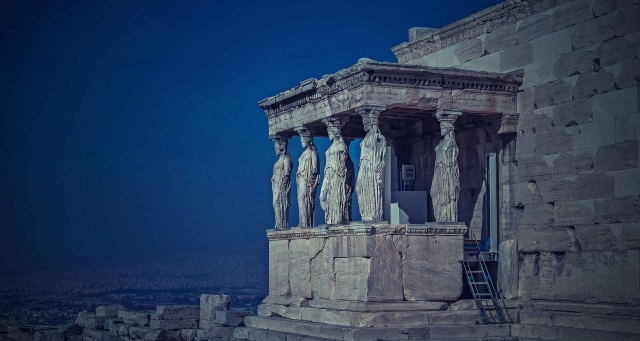
The exact origin of the study of sacred geometry is unknown, yet we can be sure it is quite ancient.
One aspect of ancient study is the Seven Liberal Arts.
The Seven Liberal Arts consist of the Trivium and the Quadrivium.
The Trivium, meaning, ‘the place where the three roads meet’ stretches back to the 8th century and the Carolingian Renaissance.
The Quadrivium is far older. Although the term ‘Quadrivium’, meaning ‘four ways’, wasn’t coined until Boethius in the 6th century, the study of the Quadrivium goes back to at least the time of Pythagoras. However traces of it can be found in Babylonian, Chaldean, ancient Egyptian and ancient Hindu cultures.
The Trivium and Quadrivium together prepare the student for the serious study of philosophy.
The Trivium
The Trivium consists of Grammar, Logic and Rhetoric.
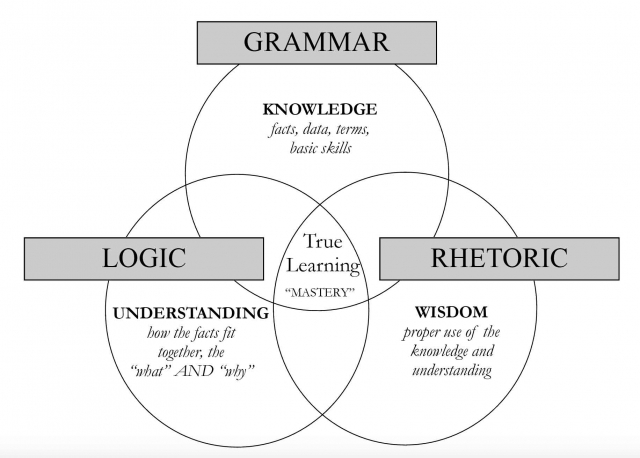
Grammar refers to the mechanics of language and the defining of objects and information perceived by the five senses (Input or facts, data, terms, basic skills).
Logic refers to the mechanics of thought and analysis. This includes identifying fallacious arguments and statements, removing contradictions, and producing factual knowledge that can be trusted. (Processing, or What and why?)
Rhetoric refers to the application of language in order to understand and persuade the listener and reader. (The proper use of knowledge and understanding.)
The Trivium “is the knowledge (grammar) now understood (logic) being transmitted outwards as wisdom (rhetoric).”1
The three together represent “Mastery” or true learning.
Below we will see that the Trivium has yet another meaning, that of the True, the Good, and the Beautiful. These are the properties of being that correspond to human reality.
That is, science corresponds to truth; the arts to beauty; and spirituality to goodness.
The Quadrivium
The Quadrivium consists of Arithmetic, Geometry, Harmony and Cosmology.
Objective laws of harmony, cosmology, number and geometry act as a framework for the multitudinous melodies of individuality to discover the common scales on which all melodies are based.
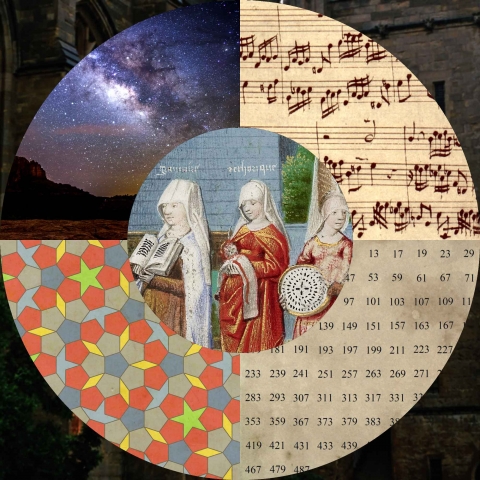
Arithmetic is Number. It deals with quantities. It is ‘Pure Number’.
Geometry is Number in Space. It deals with magnitude at rest. It is ‘Stationary Number’.
Harmony/Music is Number in Time. It deals with relations between quantities (ratios and proportions). It is ‘Applied Number’.
Cosmology/Astronomy is Number in Space & Time. It deals with magnitude inherently moving. It is ‘Moving Number’.
It can be seen that ‘Number’ itself – that is, ‘Pure Number’ is the foundation for all the other branches of study. Number becomes Geometry; Geometry becomes Music/Vibration; and Vibration becomes Cosmology (Physical Reality).
Plato said, “Numbers are the highest degree of knowledge, it is knowledge itself.” He insisted number to be the first study to embark upon as it “frees the mind from attending to actual objects and raises it to the realm of abstract principles and archetypes.”2
Pythagoras said, “All is number.”
St. Augustine said, “Numbers are the thoughts of God.”
Clearly Number (and the essence in Number) were highly revered by the ancients. But, you may ask, how can things come from numbers? How can Number be at the root of material creation? Aristotle, in his Metaphysics, ventures an answer:
“Now the Pythagoreans, seeing that many attributes of numbers belong also to sensible bodies, believed that things themselves are numbers, not separate numbers but composed of numbers as their elements. Why? Because the attributes of numbers belong inherently to musical scales, to the heavens, and to many other things.” From this we return to the ancient harmonic-geometric model of the Cosmos: Harmonic vibration, represented by numbers and harmonic numeric ratios, lie at the foundation of all in physical reality. Everything is made of energetic wave structures oscillating, vibrating, pulsating and rotating at various frequencies and wavelengths. “In the Platonic or Pythagorean mind, for which number logistics were based on harmonic motion, the unit finds its expression not as a particle, but rather as a wavelet,” Robert Lawlor tells us. “Thus limit becomes a perceptional limit of vibrational experience, not a material one, and limit is reached through consciously heightened perception rather than through the analysis of matter.”
Simply put, the Pythagorean theory of musical harmonics and number is the very marrow of esoteric sciences throughout the ages.
The Quadrivium was the major intellectual discipline of classical education consisting of Number, Geometry, Harmony, and Cosmology. A complete study of these topics were formulated and taught by Pythagoras as the ‘Tetraktys’ around 500 BCE. It was also taught by Plato and outlined in The Republic (380 BCE). It was next taught by Proclus (412-485 AD).
Robert Lawlor explains, “The implicit goal of this education was to enable the mind to become a channel through which the ‘earth’ (the level of manifested form) could receive the abstract, cosmic life of the heavens.”

“The cosmos is the holiest of shrines.” ~ Proclus
Keith Critchlow adds, “All these studies offer a safe and reliable ladder to reach the simultaneous values of the True, the Good, and the Beautiful [the Trivium]…The goal of studying these subjects was to climb back (up) to Unity through simplification based on the understanding gained by engaging in each area of the Quadrivium.
The goal lay in finding their source (traditionally this was the sole purpose of the search for knowledge)…Thus, time and wisdom tested, the Quadrivium offers the sincere seeker the opportunity to regain their own inner understanding of the integral nature of the universe, with themselves as an inseparable part.”
In other words, the key of this knowledge is the ability of individual human beings to remember: You are a cosmic being; when you die you do not disappear, you retain your unique identity; You are on a cosmic journey that deals with the evolution of consciousness and spirit; You are an integral part of the Universe; The Universe leans in your direction; Your thoughts, emotions, beliefs, actions and words are profoundly important to the evolution of the Universe; Your worth and importance is measurable beyond value; You are not a victim to a cold, random, meaningless Universe; You are a cosmic soul – a Higher Cosmic Self – and this self wants you to remember who you are so that you can live the meaningful life that is your birthright.
Pythagoras
Before we explore each of the four studies of the Quadrivium in more detail, we will take a closer look at the life and teachings of Pythagoras, as he had one of the most profound impacts on the consciousness of western philosophy and science. Although Pythagoras is more well-known than many ancient philosophers and belief system, Pythagorean epistemology is actually common to all the spiritual traditions of the world. In other words, it was in the very nature of things. Pythagoreanism, though revolutionary, is not original. It is simply one branch on the tree of the Perennial Philosophy.
“As we are the seeds generated from the plant which spring from the seed which was Pythagoras, so was Pythagoras, too, a seed sprang from another plant.” ~ Christopher Bamford
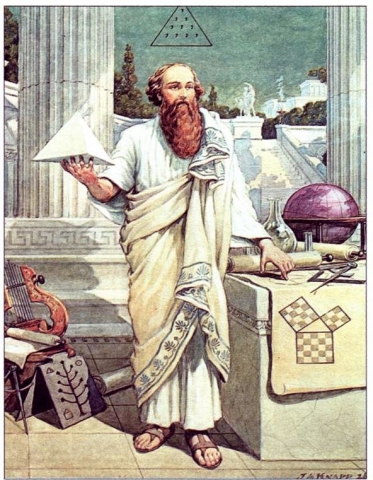
“There are many mysteries surrounding Pythagoreanism” Anne Macaulay tells us: “where did Pythagoras get his wisdom? What is the connection between Pythagoras and the subsequent Pythagoreans in Athens – Plato, Socrates, etc. – with whom there was no direct intermediary? Why did Pythagoreans “worship” Apollo when their philosophy was “beyond” religion?”
Pythagoras was born around 570 BCE and died around 495 BCE. Manly P. Hall tells us in the Secret Teachings of All Ages that strange legends surround his birth. His life parallels the life of Jesus in many fascinating ways leading us to believe that the accounts of his life are more mythological than strictly accurate. “The name Pythagoras itself must be a conferred name,” Anne Macaulay tells us. “For it means “pithia” Apollo’s temple and “agoras” the place. As the Apollo establishments were in a crisis point at the time of Pythagoras, it would appear that he was commissioned to make the secret wisdom public for the first time.”
Pythagoras was believed to have come from an immaculate conception like Jesus. They were both natives of Mediterranean countries. They both had fathers who were prophetically informed that their wife would bring forth a son who would be a benefactor of mankind. They were both born when their mother was on a journey. Both of their mothers claimed to have had contact with a ‘holy ghost’ and both were known as the ‘son of God.’
Pythagoras was thoroughly knowledgeable in Oriental and Occidental esotericism, as was Jesus. He was instructed by Rabbis in the secret traditions of Moses and he was initiated into the following Mysteries, learning much about God, Nature and Humanity: Egyptian, Babylonian, Chaldean, Isis (in Egypt), Adonis (in Syria), and the Brahmans (in Hindustan).
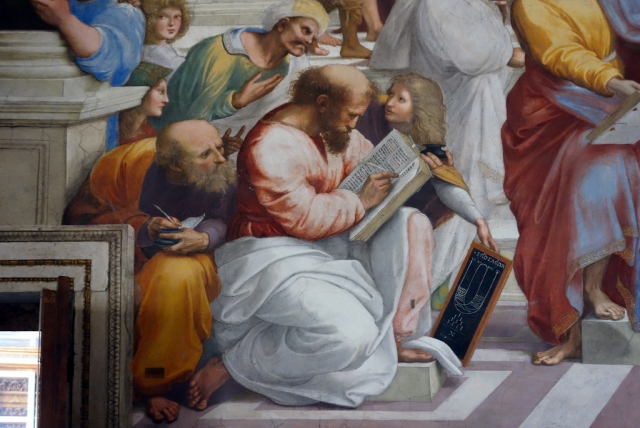
Mark Booth, in The Secret History of the World, has this to say about Pythagoras:
“Pythagoras was born on the prosperous Greek island of Samos in about 575 BC, as the first blocks of marble were being placed one on top of the other on the Acropolis in Athens. No individual has had a greater influence on the evolution of Western esoteric thought. Pythagoras was regarded as a demi-god during his lifetime. Like Jesus Christ, nothing he wrote has come down to us, only a few collected sayings and commentaries and stories written by disciples.
His wisdom was the result of years of research and multiple initiations into Mystery schools. He spent twenty-two years learning the secrets of the Egyptian initiate priests. He also studied with the Magi in Babylon and the descendants of the Rishis in India, where a memory was preserved of the great wonder-worker they called Yaivancharya. Pythagoras was seeking to synthesize esoteric thought from all around the world into a comprehensive cosmo-conception – what Leibniz, the seventeenth-century mathematician and Cabalist, would later call the Perennial Philosophy.”
Manly P Hall goes on to tell us that Pythagoras coined the word philosopher– meaning ‘one who is attempting to find out’. “The philosopher is the friend, the intimate, of wisdom – who holds amicable discourse with her,” Christopher Bamford says of the Pythagorean view of philosophy.
He demanded of all who came to him for study a familiarity with arithmetic, music, astronomy, and geometry. He conceived mathematics to be the most sacred and exact of all the sciences. Yet he was primarily a ‘religious’ teacher. “Pythagoras’s bringing of these three together – religious, scientific and philosophic – in a new way, with a social and artistic vision also,” writes Christopher Bamford, “is what from ancient times accorded him the status, quite specifically, of a religious genius, one blessed with a religious revelation or mission.”
All show us Pythagoras as a man who, because of his views on cosmic order, felt called upon to form and lead a human community to teach people to take their appropriate place in the cosmos. He thus established a community where all the members were of mutual assistance to one another in the common attainment of the higher sciences. He affirmed as cosmic law the primary principle of universal amity or friendship which could be achieved by temperance, responsibility, affection, honesty, respect and spontaneity.
“The tension between scientific investigation and a religious life which creates so much discord in our age seems to have produced harmony for the Pythagoreans,” writes Arthur G. Zajonc
He introduced the discipline of retrospection as essential to the development of the spiritual mind. He taught nothing to his disciples before the discipline of silence – silence being the first rudiment of contemplation.
Christopher Bamford explains the process of entry to the Pythagorean community: “First, an oral interview; next, a probationary period of observation; then a period of neglect, a three year residency on the periphery of the community; then, finally, entrance into the community, which began with a five-year silence. During this period one could listen, but not question; music and chanting were daily employed, both as purification and as worship – and there was dancing. At then center of these he placed a religious emphasis: for the young, philosophy; for the Elders, the Temple of the Muses; and for the women, leadership in devotion.
Next came the real mathematics or practices; arithmetic, geometry, theory of music, stereometry, astronomy, music. These were still a means and not an end…The one end of Pythagorean philosophy was to become a producer of genuine knowledge. That through which the mind understands is one with that through which the world is created, so that knowledge of mind is knowledge of creation.”
They key is thus the reunion of mind and nature, being and becoming, humanity and the universe…in short, the redemption and transfiguration of the Cosmos.
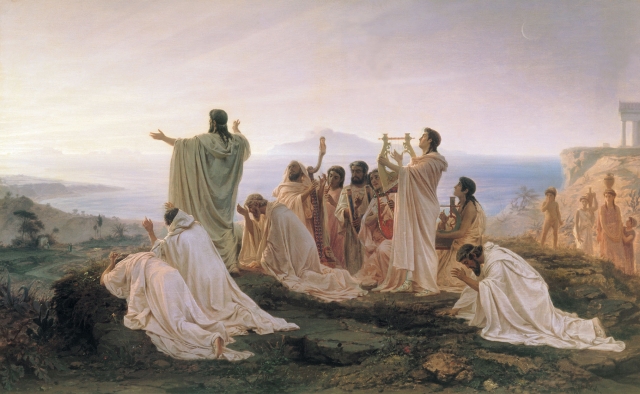
The God of Pythagoras was the Monad, or the ‘One that is Everything.’ The Monad is a homogeneous field of imperishable monadic units, analogous to the cosmic Aether of Western science and to the mythic image of creation arising from a vast, undifferentiated vibratory ocean. This Monad also refers to Universal Consciousness defined as pure Unity infinitely replicating itself as monadic units. “The undifferentiated monadic field must be configured as Form-Idea in order to express its being,” Robert Lawlor tells us. “Everything which exists has a form. Form is the antagonist of limitlessness and makes possible both quantity and quality. Form is the fixing of Number into realized relationships.”
Manly P Hall explains: to Pythagoras God is “the Supreme Mind distributed throughout all parts of the Universe – the Cause of all things, the Intelligence of all things, and the Power within all things.”
The ‘Motion of God’ was circular and the ‘Nature of God’ was truth.
The ‘Body of God’ was composed of light. Pythagorean science was attempting to build an entire cosmology on observations of the laws of sound frequencies assuming a fundamental qualitative identity between light and sound. Thus the symbolism and essence of light actually figured very heavily into Pythagorean philosophy. Robert Lawlor explains: “The Pythagorean philosophy begins with the examination of the structure of number and geometric symbol, exploring their inner relationships with the natural world and the worlds of mind, both of which are, in the Pythagorean sense, fabrications of light…Visible light is of the same nature as sound except that it has attained a critical velocity. The expression of this velocity in perception is form-color. Pythagoras said ‘Color is Form, and Form is color.’
Audible sound is then analogous to invisible light (pure light, or darkness), but at a lower octave of vibration and in a pre-formative or rudimentary phase of form expression. The fact that sound is a form-bearing stage of vibratory organization has been amply verified in our day by audio-holography and by the science of Cymatics. The logic of Pythagoras is [thus] the logic of light and vibration. It is inclusive of the concept of an octave contained within an octave, but it also understands that the essential form-nature of an octave (the consonance of its proportions) is connected to all other octaves through resonance…The Pythagorean inquiry into the relationship between symbol and reality does not have an historical termination, but continues whenever we understand more precisely the world of light in which we live and which lives in us.”
Pythagoras taught reincarnation. Proclus says that the Pythagoreans recognized that everything we call learning is remembering. Robert Lawlor explains, “Pythagoras believed that only by gaining control over the release of the KA [the emanating energy field or ‘double’] and by remembering what was learned and experienced during the journeys could one gain access to memories of previous incarnations and thus consciously participate in the developmental process occurring lifetime after lifetime. The value of the conscious journey of the double was the revelation of the interrelatedness of the individual with his complete ancestral lineage as well as of one’s destiny within the entire cosmic process. The other important aspect of what should be a universal human initiatic process is that the fear of death subsides as one develops a sense of and familiarity with the presence and control of the double…The KA [double] is that which generates all that is truly physically beautiful or repellent and deceitful. Like Narcissus, if we do not acknowledge the soul as the source of Truth, Beauty and Reality within our own nature, we lock ourselves into illusionary, materialistic fascinations and empty egoistic conquest.”
Pythagoras also taught moderation in all things rather than excess in anything. He warned his disciples when they pray they should not pray for themselves. He declared eating meat clouded the reasoning faculties, and he discovered music had great therapeutic power.
He was opposed to surgery in all its forms and would not permit the disfigurement of the body. He also believed all planets were alive and suns and planets were magnificent deities worthy of adoration and respect.
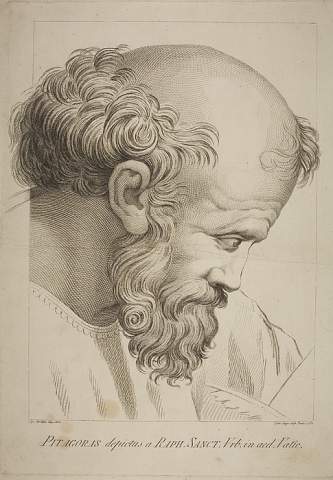
Pythagoras had many aphorisms, including:
“Above all things, respect yourself.”
“Do not yield to temptation except when you agree to be untrue to yourself.”
“All bonds without friendship are shackles, and there is no virtue in their maintenance.”
“Wisdom is the understanding of the source or cause of all things.”
“Men come to life as to a festival: most come to buy and sell and compete in the many competitions that are offered, but some come simply to observe, revere and contemplate the order, beauty and purpose of what is occurring, the golden unifying thread of essential wisdom that holds, binds all together.”
In The Golden Verses of the Pythagoreans Pythagoras said, “And thou shalt know that Law hath established the inner nature of all things alike.”

The ‘Pythagorean Y’ represented the ‘Forking of the Ways’. It symbolized the power of choice and the sanctity of free will. This choice refers to choosing to work for the ‘Greatest Good’ (Unity) or choosing to work for the ‘Individual Selfish Good’ (Separation). One cannot choose both.
The ‘Pythagorean Y’ represents one of the core precepts of the esoteric stream of knowledge, one that shows up in literature, art, and many, many spiritual traditions. It represents the necessity for each person to consciously make a choice between the two paths – the path of working for the greatest good, or the path of working for the selfish good. Until one makes the choice, they will be swept from shore to shore, battered among the rocks in the chasm of indifference. Life without a dedicated direction leads to chaos, confusion and pain. Once a choice is made and the person honestly attempts to live accordingly, the consequences will be reaped, whether they be positive consequences or negative consequences. It all depends on the choice.

Of course it is wise to remember, as it is said in Led Zeppelin’s Stairway to Heaven, “Yes, there are two paths you can go by, but in the long run there’s still time to change the road you’re on.”
“The neophyte must then choose whether he will take the left-hand path and, following the dictates of his lower nature, enter upon a span of folly and thoughtlessness which will inevitably result in his undoing, or whether he will take the right-hand road and through integrity, industry, and sincerity ultimately regain union with the immortals in the superior spheres.” Manly P Hall

Pythagoras also developed a complex and beautiful system of mathematics, geometry, music and color. He said, “All things consist of three,” and “Establish the triangle and the problem is two-thirds solved. He is perhaps most commonly remembered by the Pythagorean Theorem:
a2 + b2 = c2
He declared numbers began at 3 (the triangle) and 4 (the square). Adding to those 1 and 2 – the parents of numbers – gave 10. 10 was the great number of all things, the archetype of the universe. To him, the quality of a numerical value was considered over and above the arithmetic quantities.
The pentagram was a common symbol of health to the Pythagoreans as five-pointed geometry symbolized life, health and regeneration. It also held within it the powerful symbolism of the Golden Ratio and related to the Pythagorean teachings founded upon the idea of an ‘Eternal Law’ active in both Time and Space. “This ‘Law’ presented itself as the proportional principle of the Golden Mean,” Robert Lawlor tell us. “In other words, each creature must discover its preordained function in relationship with all other creatures, as well as by participating and supporting the ‘Divine Plan’ and ‘original purpose of creation’.”
He also regarded the five regular symmetric solids (Platonic Solids) with the greatest importance.
One note: Pythagoras, Plato, Aristotle and Euclid did not have written numerals. They used small stone spheres of pebbles to do their math.
We will cover the Pythagorean philosophy and Pythagorean mathematics in greater detail in subsequent articles. We will now turn back to the Quadrivium.
The Quadrivium: Number, Geometry, Harmony, Cosmology
Number (Arithmetic)
“Arithmetic, as it was studied in the ancient world, is hardly recognizable as a relation of the subject applied today to the torture of schoolchildren…The old method of teaching arithmetic, by showing the relationship of numbers to shapes, was designed to illustrate basic principles and to lead the minds of children into the habits of reason.” John Michell
A whole number is called a ‘quanta’. The study of quanta deals with: factors, ratios, triangular, square and cubic numbers, prime and perfect numbers, and the way numbers appear in sequences such as the Fibonacci and Lucas sequences.
There are three levels to Number. These are:
- The materially numbered
- The mathematician’s number (indefinite)
- The Ideal or Archetypal Number (complete at 10)
“In Platonic thought,” Robert Lawlor states in Homage to Pythagoras, “Number as proportion and principle should never be separated from the concept of geometric form. Plato believed that this maintained connectivity between the changing, perishable world of particulars and the world of eternal, intelligent being (Eidos). Plato intended mathematics to be a method of activating our capacities of counting, reasoning and, as well, intuition.”
Architect Paul Jacques Grillo, in 1960, commented: “The world around us is a world of numbers – numbers that spell life and harmony. They are organized by the geometry of figures, all related to one another according to a sublime order, into dynamic symmetry. Glimpses into this magnificent kingdom form the basis of all our knowledge and it seems that in this domain the ancient civilizations had gone further than modern science.”
John Michell writes, “In the writings of the old philosophers, there is common agreement that the true purpose of number is for investigating the universe.”

Lawlor continues, “We forget that number continuity really only progresses through a wave-like alternation (odd-even), that there are no discontinuous magnitudes nor discrete parts, that a unit can never exist outside of a contiguous form/flow…In the Platonic or Pythagorean mind, for which number logistics were based on harmonic motion, the unit finds its expression not as a particle, but rather as a wavelet. Thus limit becomes a perceptional limit of vibrational experience, not a material one, and limit is reached through consciously heightened perception rather than through the analysis of matter.”
“The Pythagoreans held number in the very highest regard. In fact they held that it was the nearest the human mind could get to participating with the Divine Mind. Be that as it may, the impulse that grew out of the Pythagorean community eventually gave birth to the Platonic and Socratic doctrines, those that saw mathematics, psychology and cosmology as completely integral – each being a reflection of the other: what today we might call ‘aspects of universal consciousness’.”3
As far as number and arithmetic is concerned, it is the one subject we know of in which everyone consents to its nature and behavior. It is an unambiguous universal language – one that we can all agree on.
However, the symbolic level of number will differ according to times, cultures and understanding.
Geometry
“Sacred Geometry charts the unfolding of number is space. It differs from mundane geometry purely in the sense that the moves and concepts involved are regarded as having symbolic value, and thus, like good music, facilitates the evolution of the soul.” Miranda Lundy
Pure geometric Form is to symbolic, utilitarian and natural form as pure sound is to language and music.
Geometry is the order of space as ‘Number in Space’. It unfolds in four stages:
- The non-dimensional point (∞)
- The line (1D)
- The plane (2D)
- Volume (3D)
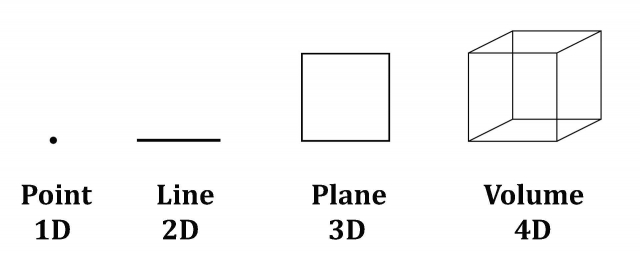
Plato, Pythagoras and those before him used pebbles to count, as there was no developed number system. As they ‘counted’ they created geometry.
As Keith Critchlow says, “Arithmetic is geometry in pebbles.”
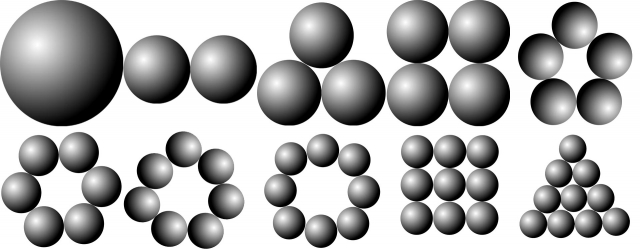
Using only perfect polygons (perfect meaning all sides and angles equal) geometry consists of:
- Three regular grids
- triangle, square, hexagon

- Five regular solids (Platonic Solids)
- tetrahedron, octahedron, cube, icosahedron, dodecahedron

- Eight semi-regular grids
- hexagon/triangle/cube; hexagon/cube/dodecagon; triangle/cube (1 & 2); triangle/hexagon (1 & 2); triangle/dodecagon; octagon/cube

- Thirteen semi-regular solids (Archimedean Solids) and their duals (13 Catalan Solids)
- snub tetrahedron, truncated octahedron, cube octahedron, truncated cube, rhombicuboctahedron, great rhombicuboctahedron, snub cube, truncated icosahedron, icosidodecahedron, truncated dodecahedron, rhombicosidodecahedron, great rhombicosidodecahedron, snub dodecahedron
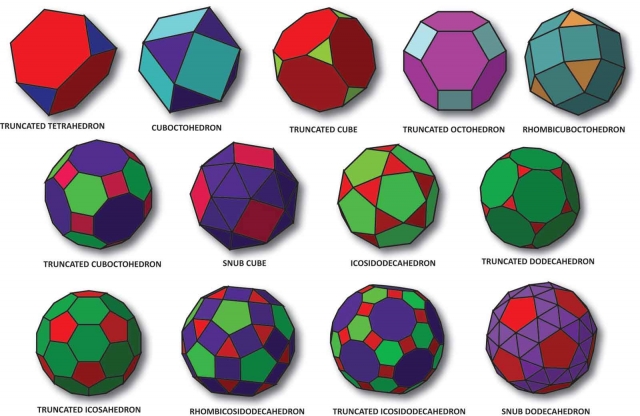
Incidentally, 3, 5, 8, and 13 are all Fibonacci numbers.
“In the hierarchy of arts, geometry ranks equal to music, expressing through visible shapes the same numerical proportions as musical harmonies present to the ear…These proportions were not derived directly from music, but rather from a common source in number as a symbol of the divine Creation.” John Michell
Harmony (Music) – “The Nature of the Soul”
“When the Soul is in harmony with itself we call it ‘peace of mind’…Wholeness and harmony can be helped by correct tuning. Health has a common root meaning with wholeness and holiness.” – Keith Critchlow
Harmony is ‘Number in Time’. It refers to frequency and harmonics. Robert Lawlor tells us the Laws of Harmonics are “considered to be universals which define the relationship and interchanges between the temporal movements and events of the heavens and the spatial order and development of the earth.”

Simple ratios exist between periods or frequencies:
- 1:1 – unison
- 2:1 – the octave
- 3:2 – the fifth
- 4:3 – the fourth
- The frequency of the fifth differs from that of the fourth as 9:8 – the value of the tone which gives rise to the scale.
Harmony displays four musical scales:
- pentatonic – 5 notes (white keys of the piano A C D E G)
- diatonic – 7 notes (white keys of the piano A B C D E F G)
- chromatic – 12 notes (white and black keys of the piano C C# D D# E F F# G G# A A# B)
- shruti – 22 notes
The key to harmonic ratios is hidden in the famous Pythagorean tetractys, or pyramid of 10 dots. See Article 78.
The tetractysis made up of the first four numbers – 1, 2, 3, 4 – which in their proportions reveal the intervals of the octave, the diapente (perfect fifth), and the diatessaron (perfect fourth).
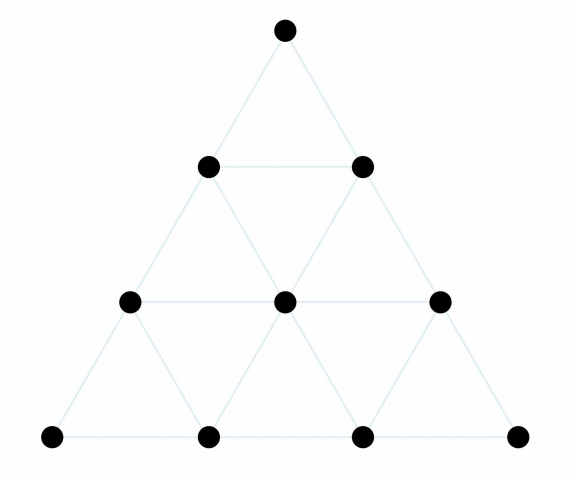
Pythagoras discovered that the seven modes, or keys, of the Greek system of music had the power to incite or allay the various emotions. He also thought that a human healthy in body and mind was like a well-tuned cithara (a stringed instrument, precursor to the guitar). These ideas of health, harmony and music also related to the tuning of the chakras.
As Manly P Hall wrote, “Harmony is a state recognized by great philosophers as the immediate prerequisite of beauty. A compound is termed beautiful only when its parts are in harmonious combination. The world is called beautiful and its Creator is designated the Good because good perforce must act in conformity with its own nature; and Good acting according to its own nature is harmony, because the good which it accomplishes is harmonious with the good which it is. Beauty is harmony manifesting its own intrinsic nature on the world of form.”
Cosmology (Astronomy)
Cosmology or Astronomy is ‘Number in Space & Time’. The word ‘cosmos/kosmos’ was originated by Pythagoras which means ‘order’ and ‘adornment’. Order meaning “the arrangement of things in relation to each other according to a particular sequence, pattern or method.” Adornment meaning “adding grace, beauty, or honor.”
“The Pythagoreans viewed the visible heavens as an ‘adornment’ of pure principles, the number of visible planets relating to the principles of proportional harmony. The study of the perfection of the heavens was a way of perfecting the movements of one’s own soul.” Keith Critchlow
The “Kosmos” of the solar system was traditionally studied. The Pythagoreans found profound harmony in the geometry and mathematical ratios of the orbits of the sun, the planets, and their respective moons and the lessons they offered for spiritual evolution of human beings.
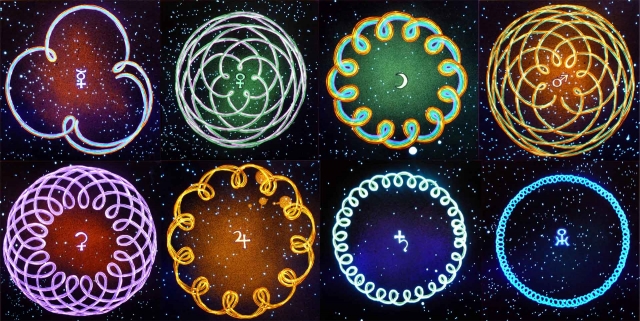
Christopher Bamford writes: “The Kosmos is that divine, true and beautiful order held together harmoniously by bonds of amity, reciprocity and affection or sympathy. The Pythagorean philosopher thus strove to align his being, unite his thinking – though these are one, not two – with the thinking and being sources of the kosmos, i.e., the Gods, Numbers or Archetypes. [Yet] Cosmos is much more than just the universe. It includes the idea of beauty, order or goodness, and structural perfection which we might call truth. All of these are held together by the prior principle of unity, which, manifesting as Cosmos – one mass of Life and Consciousness as the Corpus Hermeticum will say – becomes a teaching of the harmony, sympathy and kinship of all things – a universal interrelationship and interdependence: a harmony…and divine order, incomprehensible in itself but presiding over all things.
We will cover all four of these Quadrivium studies in detail as we move through Cosmic Core.
Plato is one of the most well-know spokespeople for Pythagorean philosophy yet Plato was a complicated character – an elite who subverted Pythagorean values and tried to push a totalitarian society and associated philosophy onto humanity. See Article 265
Pythagoras belonged to the older, mystical and yogic tradition, while Plato, using the same body of knowledge, begins the path of individualistic philosophy and contemplation. Plato also stressed the importance of the noetic thought realm over the somatic physical realm. This did not exist in Pythagoreanism, as Pythagoras viewed the harmony between the two equally important realms as more important than stressing one realm over the other.
Plato did however stress the importance of Unity: “Every diagram and system of number and every combination of harmony and the agreement of the revolution of the stars must be made manifest as one in all to him who learns in the proper way, and will be made manifest if a person learns aright by keeping his mind’s eye on unity; for it will be manifest to us as we reflect, that there is one natural bond linking all things.” Plato, Epinomis
“The Pythagorean ethos of the necessity of a simultaneous pursuit of the True, the Beautiful, and the Good was profoundly and integrally transmitted in the words of Plato and becomes a reminder, when dwelt upon, that there are at least three fundamental aspects of our nature that require nourishment. Thus there is an insistence upon simultaneous concern for all three values to ensure a balanced diet. Our minds require Truth, our values require Beauty, and our wholeness, or soulness, requires the ultimate Good…Three values that are ever true and life-supporting.”6

“Pythagoras traveled to many centers of ancient culture and sacred knowledge, yet he created a ritual and practice uniquely his own, suited for his people and age. Is it not incumbent upon us to do likewise? Certainly, we also may travel to temples and study the traditions of sacred knowledge, but must we not also likewise master the knowledge and methods of our own age?” ~ Arthur Zajonc
- https://en.wikipedia.org/wiki/Trivium
- Michell, John, The Dimensions of Paradise, Inner Traditions, 2nd edition, 2008, pg. 49
- Critchlow, Keith, The Hidden Geometry of Flowers: Living Rhythms, Form and Number, Floris Books, 2011
- ibid.
- ibid.
- ibid.
Recent Comments